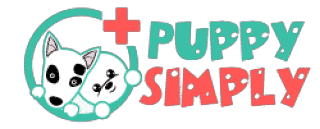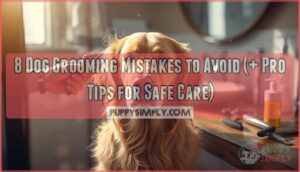This site is supported by our readers. We may earn a commission, at no cost to you, if you purchase through links.

Cheerios are low in sugar and safe in small amounts, but they don’t provide much nutrition for your pup.
Stick to plain varieties—flavored ones like chocolate or honey nut can contain ingredients harmful to dogs.
Also, avoid overfeeding since too many can lead to weight gain or upset stomachs.
Think of them as the equivalent of an occasional cookie for us—fun but not essential, and consider them a healthy alternative only in the context of an occasional indulgence.
If you’re looking for healthier options, there are better treats, and curious about healthier alternatives, let’s explore your options.
Table Of Contents
- Key Takeaways
- Can Dogs Eat Cheerios Safely
- Are Cheerios Good for Dogs
- Health Risks of Cheerios for Dogs
- How Many Cheerios Are Safe for Dogs
- What Happens if Your Dog Eats Too Many Cheerios
- Choosing The Right Cheerios for Dogs
- Nutritional Value of Cheerios for Dogs
- Alternatives to Cheerios for Dogs
- Frequently Asked Questions (FAQs)
- Conclusion
Key Takeaways
- Dogs can eat plain Cheerios in small amounts, but they don’t offer much nutritional value and should only be an occasional treat.
- Avoid flavored Cheerios like chocolate or honey nut, as they can contain harmful ingredients such as theobromine or added sugar.
- Cheerios are low in calories but can contribute to weight gain or digestive issues if overfed, so stick to minimal portion sizes.
- Healthier alternatives like plain cooked oatmeal, green beans, or carrots provide more nutritional benefits without the unnecessary additives.
Can Dogs Eat Cheerios Safely
You can safely give your dog plain Cheerios in small amounts, but they don’t offer much nutritional value.
Flavored varieties, especially those with added sugar or toxic ingredients, should generally be avoided.
Plain Cheerios Vs Flavored Varieties
When feeding your dog Cheerios, not all varieties are created equal.
Plain Cheerios are the safest choice because they’re made with simple whole grain oats and have low sugar content.
Plain Cheerios offer a crunchy, low-sugar snack that’s safe for dogs in small amounts, but they lack real nutritional value.
On the other hand, flavored Cheerios need extra caution.
Their sugar content and artificial sweeteners can cause unnecessary health risks for your pup.
For example, Honey Nut Cheerios contain added sugar and almonds, which aren’t ideal.
Worse yet, chocolate-flavored Cheerios have toxic ingredients like theobromine, making them off-limits.
Always stick to safe flavors and carefully check ingredient lists!
Here’s what you need to keep in mind:
- Plain Cheerios: The safest with minimal sugar.
- Flavored Cheerios: Avoid due to added sugars and artificial ingredients.
- Toxic Flavors: Chocolate and nutmeg are especially dangerous.
Potential Risks and Allergic Reactions
Cheerios might seem harmless, but they can pose risks to your dog.
Cheerios are safe in small amounts but watch for risks like allergies, choking, or digestive issues.
Some dogs have wheat allergies or sugar sensitivity, leading to symptoms like digestive upset or itchy skin. Flavored varieties may contain toxic ingredients—like nutmeg in Pumpkin Spice Cheerios—that can cause serious issues.
High sugar and salt levels in Cheerios are also concerns, potentially leading to dehydration or weight gain.
Always monitor your dog for allergic reactions, such as vomiting or unusual behavior, after introducing Cheerios. When in doubt, consult your vet to guarantee their safety.
Are Cheerios Good for Dogs
Cheerios can be a safe treat for your dog, but they don’t offer much nutritional value.
While they’re not harmful in small amounts, they shouldn’t replace healthier options in your dog’s diet.
Nutritional Value and Limitations
Regarding Cheerios and dog nutrition, the truth might surprise you. Cheerios may seem like a healthy snack, but they’re more of a fun indulgence than a nutritious choice for dogs.
Let’s break it down.
- Empty Calories: One cup has 100 calories, which can pile up quickly, especially for smaller dogs.
- Fiber Source: While whole grains offer some fiber, it’s not enough to make a big difference for your dog’s digestion.
- Missing Nutrients: Cheerios are fortified with vitamins, but your dog’s regular food already provides everything they truly need.
- Vitamin Content: Though nutritious for humans, Cheerios aren’t formulated to meet a dog’s dietary requirements.
In short, Cheerios are safe in moderation but don’t offer much for your dog’s health.
Think of them as an occasional snack, not part of a balanced dog diet.
Due to their high carbohydrate content, excessive Cheerios can lead to weight gain.
Alternatives to Cheerios
If you’re looking for healthier options than Cheerios, there are plenty of alternatives to explore.
Vegetable dog treats, like fresh green beans or carrot sticks, can provide a crunchy, low-calorie snack. For grain options, oatmeal benefits your pup’s digestion—just cook it with water. You can also try plain rice cakes as a light treat.
For variety, here’s a quick comparison:
| Treat | Key Benefit | Caution |
|---|---|---|
| Green beans | Low-calorie, crunchy snack | Avoid adding salt or seasoning |
| Oatmeal (plain) | High in fiber | No milk or added sugar |
| Plain rice cakes | Light, crispy alternative | Watch for choking on large pieces |
Consider purchasing healthy treat options for your dog. Stick with safe foods for dogs and consult your vet for dog diet recommendations!
Health Risks of Cheerios for Dogs
Feeding your dog Cheerios might seem harmless, but there are risks you need to bear in mind.
From potential weight gain to choking hazards and allergies, these concerns can impact your dog’s health if Cheerios aren’t given carefully, considering the potential for allergies.
Obesity and Weight Gain
Keeping your dog at a healthy weight involves more than love—careful calorie control is key.
Cheerios, while tempting as treats, can sneak in extra calories that add up fast. Just one cup holds about 100 calories, nearly 10% of a medium dog’s daily needs.
An overindulgence in Cheerios can lead to weight gain and obesity, taking a toll on your dog’s overall health.
Excess weight can cause:
- Joint problems and reduced mobility
- Increased risks of diabetes
- Greater strain on the heart
- Long-term effects like shorter lifespans
Stick to small portion sizes and explore healthy alternatives, like carrots or unseasoned chicken. Pair treats with regular exercise to keep your pup happy and fit!
Choking Hazards and Digestive Issues
Small treats like Cheerios might seem harmless, but they can pose surprising dangers, especially for smaller dogs and puppies.
Cheerio size matters—a pup might gulp them too quickly, leading to choking hazards or swallowing issues.
Here’s why careful supervision is key:
- Choking risks: Dry Cheerios can easily get lodged in your dog’s throat.
- Bowel obstruction: Eating too many could cause serious digestive problems like blockages.
- Digestive sensitivities: Some dogs might experience stomach upset or bloating after consuming them.
- Puppy concerns: Younger dogs are more prone to issues with smaller, harder foods.
Always provide Cheerios in tiny amounts and watch closely.
It’s better safe than sorry regarding your furry friend’s health.
Allergies and Dental Problems
Dogs with wheat allergies or sensitivities to other ingredients in Cheerios, like oats, might face itching, upset stomachs, or other allergic reactions.
It’s also worth noting that the sugar content, while low, can contribute to dental health issues like tartar buildup and eventual dental decay.
Over time, this can affect your dog’s overall dental health. To prevent problems, choose plain Cheerios sparingly, monitor for any ingredient sensitivity, and always prioritize your dog’s diet over treats.
Common Symptoms and Warning Signs
It’s important to watch for warning signs if you’re questioning, "Are Cheerios safe for dogs?" Some symptoms can signal trouble after your pup munches on them.
Here are key symptoms to monitor:
- Vomiting and diarrhea: These may indicate stomach upset or potential sugar toxicity.
- Allergic reactions: Look for itching, face swelling, or unusual behavior.
- Digestive problems: Signs include restlessness, excessive gas, or meal refusal.
- Poisoning symptoms: Nutmeg poisoning from certain Cheerios flavors causes dry mouth, agitation, or trouble walking.
How Many Cheerios Are Safe for Dogs
You should only give your dog a small handful of plain Cheerios as an occasional treat.
Stick to a limit of a few pieces to guarantee they stay safe and healthy.
Feeding Guidelines and Portion Control
In regards to feeding Cheerios to dogs, moderation is the golden rule.
Treats like these should only make up about 10% of your dog’s daily calorie intake—that’s the “Treat Percentage” you need to keep in mind.
A few Cheerios, such as 2-3 pieces for training or up to 10 for special occasions, are plenty.
Stick to Daily Limits to avoid unnecessary weight gain or health issues.
Cheerios work best as tiny “dog snacks,” perfect for training rewards.
Keep portions small, and avoid making them a regular food component.
Think of them as a crunchy bonus, not a meal replacement.
Always Supervise Feeding to prevent overindulgence, especially if your pup gets too excited.
If you’re in doubt about serving frequency or portion size, a Vet Consultation makes certain you’re making the best choice for your furry friend.
Factors Affecting Safe Consumption
When deciding how many Cheerios are safe for your dog, it’s not as simple as pouring a bowl. Several factors play into your dog’s tolerance for this popular cereal.
A larger dog, like a Labrador, can handle more Cheerios than a small Yorkie. Puppies or older dogs may have more sensitive stomachs, so moderation is key.
Dogs with conditions like diabetes, obesity, or allergies should avoid sugary cereals entirely. Always check with your vet before introducing new foods.
Some dogs don’t tolerate grains or sugar content well. Monitor for signs like upset stomach or allergies.
Remember, whether it’s Cheerios for dogs or any other cereal, stick to small portions. Treats should only make up 10% of their daily food intake. Always prioritize your dog’s health and consider their individual needs, as every dog is different, and some may require special care due to their specific conditions, such as sensitive stomachs.
What Happens if Your Dog Eats Too Many Cheerios
If your dog eats too many Cheerios, it might end up with an upset stomach or loose stools.
In some cases, overconsumption can lead to more serious issues like weight gain or digestive discomfort.
Symptoms of Overconsumption
Too many Cheerios can upset your dog’s stomach.
Symptoms like digestive distress—think bloating, gas, diarrhea, or vomiting—might show up after overindulgence. Be cautious of allergic reactions, such as itching, swelling, or excessive licking.
Watch for behavioral changes, like lethargy or disinterest in favorite toys, which might hint at discomfort. Over time, excessive Cheerios and their sugar content could contribute to weight gain, diabetes, or other long-term effects.
If your dog frequently seems off after eating Cheerios, consult a vet. Issues like vestibular dysfunction can also cause similar symptoms, so it’s important to rule out other potential causes.
Remember, moderation is key, and keeping Cheerios an occasional treat helps avoid the need for veterinary intervention.
Emergency Response and Treatment
If your dog eats too many Cheerios, quick action matters. Excessive intake can lead to dog poisoning symptoms, especially if toxic foods for dogs like chocolate or nutmeg are involved.
Watch for toxic ingestion signs such as vomiting, diarrhea, or lethargy.
Follow these steps:
- Call your vet for veterinary intervention if severe symptoms appear.
- Offer fresh water to prevent dehydration but don’t force drinking.
- Collect stool or vomit samples for supportive care assessment.
With proper care, most cases resolve, but long-term monitoring helps guarantee recovery.
Choosing The Right Cheerios for Dogs
When picking Cheerios for your dog, stick to plain, unsweetened options with minimal ingredients.
Avoid flavored varieties, as they often contain added sugar or toxic ingredients that could harm your pet.
Whole Grain Options and Ingredients
Finding the right Cheerios for your dog starts with understanding the whole grain foundation and ingredient safety.
Plain Cheerios are made from whole oats, offering modest fiber benefits without added sugar content or harmful sodium levels. While they’re not packed with nutrients, they make a safe, occasional snack.
If you’re curious about differences, here’s a quick rundown:
| Type | Grain Processing | Fiber Benefits | Sugar Content | Sodium Levels | Ingredient Sourcing |
|---|---|---|---|---|---|
| Plain Cheerios | Minimal | Low | Low | Low | Simple, oat-based |
| Organic Cheerios | Similar | Low | Low | Low | Organic whole grains |
| Flavored Cheerios | Processed | Negligible | High | Varies | Artificial additives |
Stick to plain Cheerios since they suit sensitive stomachs better than sugary, processed variants. Remember, these cereals are a treat, not a diet replacement!
Avoiding Toxic Flavors and Additives
Choosing the right Cheerios for your dog means avoiding toxic ingredients and harmful additives. Some flavored varieties carry hidden dangers that could jeopardize your dog’s health. For example, Chocolate Cheerios contain cocoa, which poses a serious risk of chocolate poisoning. Pumpkin Spice Cheerios are another unsafe option, as nutmeg can cause seizures, irregular heart rates, and nutmeg concerns in dogs.
Always watch out for harmful additives like artificial sweeteners and artificial colors in flavored Cheerios, as they can upset your dog’s digestive system and lead to long-term health issues.
What to avoid in Cheerios:
- Chocolate flavors: Toxic to dogs
- Nutmeg: Risks seizures, agitation
- Sugary varieties: Causes weight gain
Stick to plain Cheerios for a safe, occasional treat. Always double-check labels!
Nutritional Value of Cheerios for Dogs
Cheerios might seem like a healthy snack, but their nutritional value for dogs is limited.
While they contain whole grains and added vitamins, they don’t provide the essential nutrients your dog needs.
Whole Grains and Fiber Content
Although cereal like Cheerios contains whole grains, which offer some fiber benefits, their nutritional impact on dogs is minimal.
Oats, known for their grain digestibility, can slightly aid digestion when fed sparingly.
However, overdoing it may lead to issues.
Instead, consider Cheerios alternatives, such as pumpkin or plain, cooked oatmeal, which balance wholegrain advantages without unnecessary sugar or additives.
Fortified Vitamins and Minerals
Fortified with synthetic vitamins and minerals, Cheerios offer little nutritional value for dogs.
Their Vitamin Absorption and Mineral Bioavailability don’t align with canine needs, making them less beneficial than they seem. As a result, vitamin overdose poses a health risk.
Instead of relying on fortification benefits, focus on:
- Natural sources of nutrients from fresh foods.
- Pet nutrition with balanced dog diets.
- Avoid empty-calorie Cheerios for healthier choices.
Calorie Content and Weight Management
In the case of Cheerios, calorie density matters for weight monitoring in dogs. A single cup contains about 100 calories, which sounds small but isn’t for a dog.
Here’s the big picture:
- For a small dog, one cup could equal 15% of their daily calorie needs.
- Overfeeding leads to overweight dogs and potential joint pain.
- Lack of exercise worsens calorie imbalances, promoting dog obesity.
- Healthy treats are better alternatives.
Stick to small portion sizes and focus on pet weight management. Keeping your pup active and their diet balanced prevents weight issues.
Alternatives to Cheerios for Dogs
You’ve got plenty of healthier options if you’re looking for a better treat for your dog.
From plain cooked oatmeal to small pieces of unseasoned chicken or veggies, these alternatives offer more nutrition without unnecessary additives.
Other Whole Grain Options
In the context of healthier whole-grain alternatives, oatmeal, brown rice, quinoa, barley, and whole-wheat bread stand out.
These provide more fiber and nutrients than cereal options like Cheerios. For example, oatmeal benefits dogs with its fiber-packed wholegrain oats.
Always cook these grains plain—no salt, sugar, or butter—for safe consumption. As a treat, plain Cheerios are safe in moderation.
Introduce new grains gradually to make certain your dog’s tolerance.
Homemade Treats and Recipes
Skip Cheerios and try these homemade pet treats instead! They’re simple, healthy, and full of love:
- Peanut Butter Biscuits: Mix limited ingredients like oats and peanut butter for Healthy Dog Biscuits.
- Sweet Potato Chews: A tasty Grain-Free Recipe.
- Banana Oat Cookies: Perfect DIY Dog Snacks.
- Apple Carrot Treats: Crunchy dog treats loaded with nutrients.
Consider easy treat recipes for your furry friend.
Your pup deserves better!
Consultation With a Veterinarian
Talking to a veterinarian is the best way to plan your dog’s diet safely.
A consultation covers health history, current diet, activity level, and breed considerations.
It helps address specific concerns like allergies or underlying conditions.
If Cheerios are on your radar, veterinary advice can confirm if they’re suitable based on your dog’s needs.
Always prioritize professional guidance to avoid risks and guarantee proper dietary integration, especially in emergencies requiring immediate changes to your dog’s nutrition, with a focus on proper dietary integration.
Frequently Asked Questions (FAQs)
Can dogs eat Cheerios cereal?
You might think Cheerios are a harmless treat for your dog, and they are—in small amounts.
However, they offer little nutritional value and shouldn’t replace healthy, nutrient-rich options specifically designed for dogs.
Can dogs eat Honey Nut Cheerios?
Yes, dogs can eat Honey Nut Cheerios, but only occasionally and in small amounts.
They’re higher in sugar than plain Cheerios, which isn’t ideal.
Stick to plain flavors for a healthier option when treating.
Can dogs eat Frosted Cheerios?
Frosted Cheerios might seem like a sweet treat, but they’re not ideal for dogs.
The added sugar can lead to weight gain, dental issues, and even health problems like diabetes.
Stick to plain Cheerios instead.
Can dogs eat cereal?
Dogs can eat some cereals in small amounts, but many lack nutritional value and may contain harmful ingredients like chocolate or sugar.
Stick to plain varieties without milk, and always prioritize their health and safety first.
Is it safe for dogs to eat Cheerios?
Cheerios are as harmless as a light drizzle, but they’re not exactly nourishing for dogs.
Plain Cheerios can work as a tiny treat, but stick to moderation and avoid sugary or flavored varieties altogether.
Can dogs eat Cheerios without milk?
Feeding Cheerios without milk is fine for dogs, but stick to plain ones in small amounts.
Milk isn’t ideal since many dogs are lactose intolerant.
Always prioritize nutritious treats and monitor for any adverse reactions.
Are Cheerios good for dogs?
You might think Cheerios are a golden gift for dogs, but they’re more like an empty promise.
While they’re safe in small amounts, they offer little nutritional value and should only be occasional treats.
Can dogs eat rice Cheerios?
Sure, dogs can eat Rice Cheerios in small amounts.
They’re not toxic but don’t provide much nutritional value for your pup.
Stick to plain, unsweetened ones and offer them occasionally as a treat.
How many Cheerios can I give my dog?
Imagine your pup drooling over a treat—stick to 10-15 plain Cheerios as an occasional reward.
Keep it minimal, no more than 10% of their daily calorie intake, ensuring a balanced diet.
What cereals can a dog eat?
Dogs can safely eat plain cereals like Cheerios, Rice Krispies, or oatmeal in small amounts.
Avoid cereals with chocolate, raisins, artificial sweeteners, or high sugar.
Always check ingredients, and stick to moderation.
Conclusion
Dogs can eat Cheerios, but they’re not the healthiest treat.
Stick to plain Cheerios, avoid flavored varieties, and feed them in moderation to prevent upset stomachs or weight gain.
Cheerios lack the nutrients dogs need, so don’t use them as a regular snack.
Instead, opt for healthier, dog-friendly treats that offer real benefits.
Always watch for signs of allergies or overconsumption.
When in doubt, check with your vet to keep your furry friend safe and happy.

















